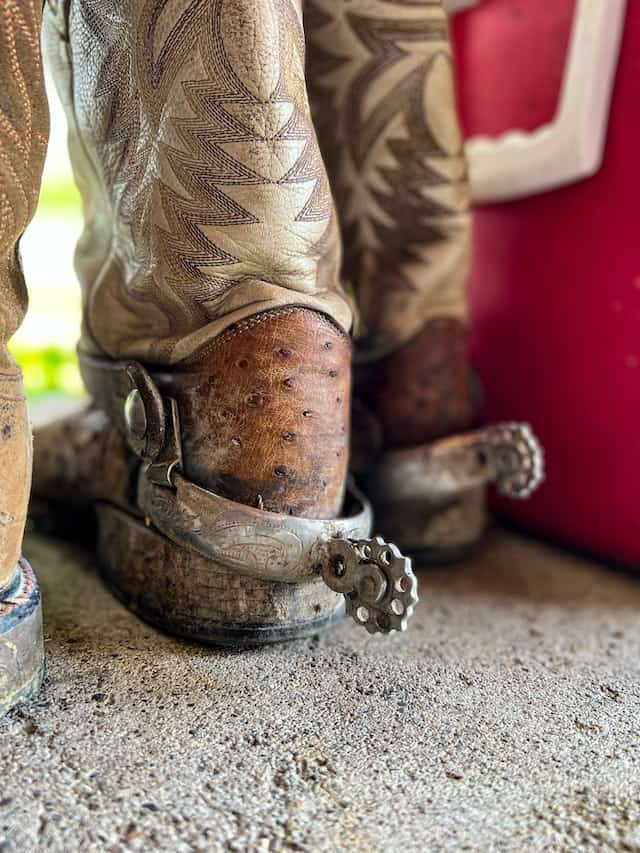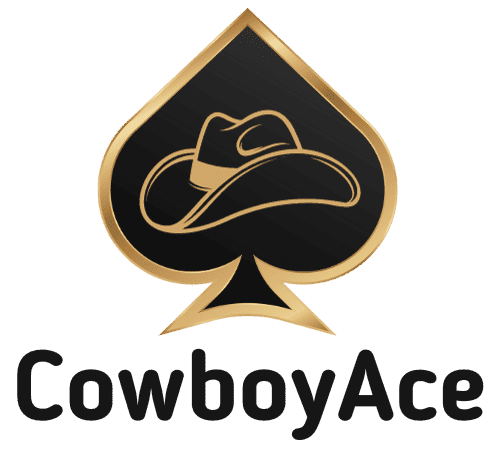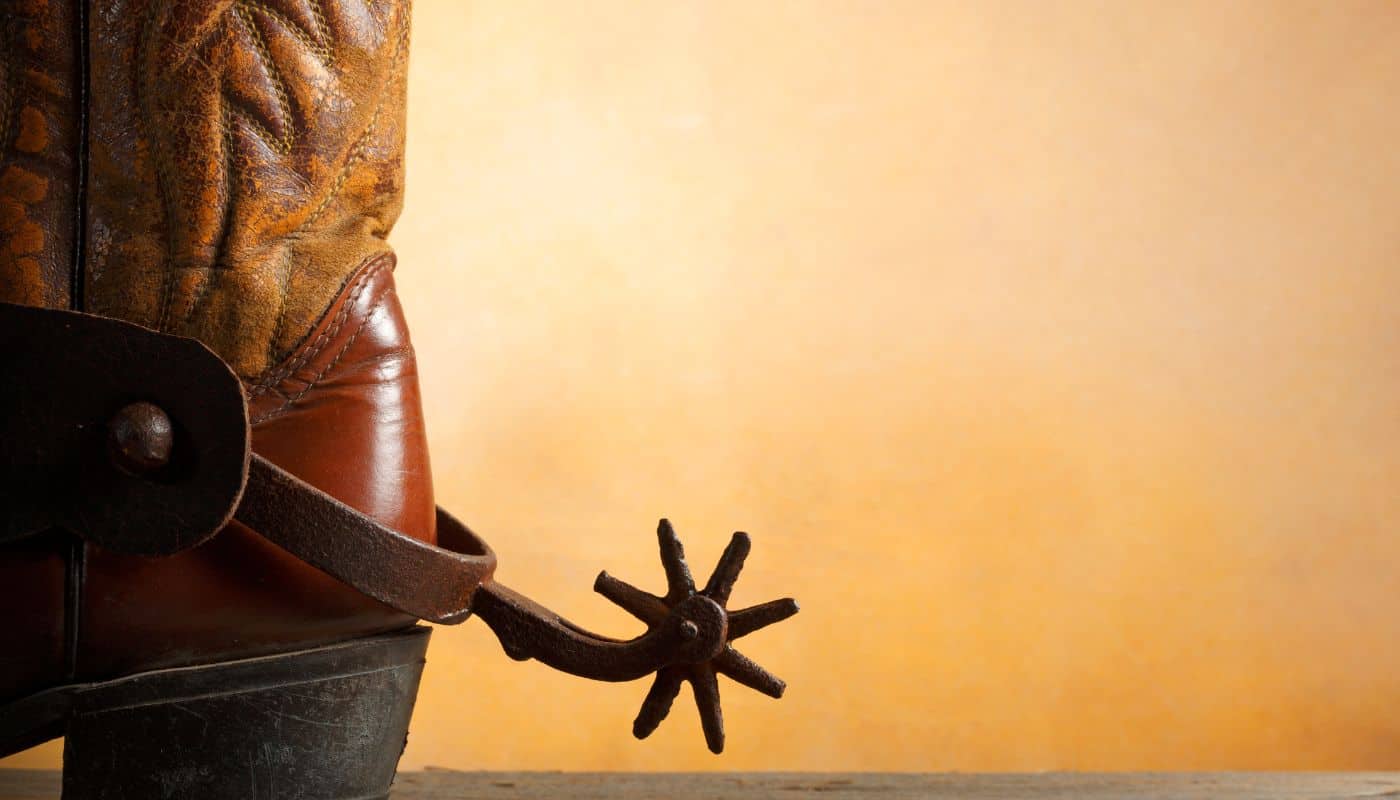Why Do Cowboys Wear Spurs?
Western spurs often accompany the image of a cowboy typically set against landscapes. These metal tools attached to their boots are not just accessories as they hold symbolic significance.
Spurs serve as aids in controlling horses with precision, enabling communication with riding aids, and ensuring safety in unpredictable terrains. In this exploration of modern spurs, we will delve into the roles that spurs play in the world of cowboys, encompassing applications across riding disciplines as well as their cultural and historical importance.
Cowboys emerged during the century in the American West as skilled horsemen and developed as an experienced rider for herding cattle over long distances to market. Their attire was a combination of practicality and style designed to withstand the conditions they faced daily.

For instance, their brimmed hats shielded them from scorching sun rays while bandanas protected their faces from dust storms. The durable denim jeans allowed them to spend hours in the saddle without tearing. However, what truly distinguishes cowboy fashion is the inclusion of spurs.

Now let’s address the question: Why do cowboys wear spurs? The answer lies in understanding how vital effective horse communication is for these riders. Western spurs are not just accessories; they establish a harmonious connection between man and beast.
By employing movements and cues with their legs while wearing spurs, cowboys can convey instructions to their equine partners. This kind of communication becomes particularly significant when herding cattle or conquering obstacles on the range.
The special connection between cowboys and horses is built on trust, and the soft sound of spurs is a sign of this partnership.
Misconceptions Surrounding Spurs and Their Purpose
Myth: Only Aggressive Riders Use Spurs
Contrary to belief, spurs are not exclusively used by riders or those who want to punish their horses. When utilized correctly, spurs serve as a means of communication. Their primary function is to provide cues to the horse rather than causing harm.
Myth: All Spurs are Sharp and Painful
A range of spurs with varying styles and types exist, not all designed to be painful. Many modern spurs have rounded edges or rubber balls at the end, ensuring they are gentle on the horse. Regular maintenance will minimize any spur marks, rubs and discomfort.
Myth: Spurs are an Ancient Tool and No Longer Necessary
While it is true that cowboy spurs have origins, their significance remains relevant in today’s world. Modern disciplines in riding, like cutting, reining, and barrel racing, herding cattle, still rely on spurs for nuanced communication with horses.
Myth: Wearing Spurs Indicates Expertise
The presence of spurs on a rider does not automatically imply expertise. Like any tool, using spurs effectively requires skill and understanding. Improper usage can confuse or even harm a horse.
Myth: Spurs are Exclusive to the Cowboys
Although commonly associated with cowboys, spurs find utility across disciplines worldwide. Different styles of horseback riding, such as English riding, dressage, and show jumping, often require spurs specifically designed to meet the needs of each discipline.
The Use of Cowboy Spurs and Animal Welfare
When used properly and responsibly, spurs do not cause harm to the horse. They serve as an extension of the rider’s leg, providing signals. However, it is important to acknowledge that, like any tool, they can be misused by careless riders. This misuse has contributed to the misconception that spurs are inherently inhumane.
Aiding in Horse Control
Spurs play a role in assisting the Cowboys in controlling their horses. They act as an extension of the rider’s leg, allowing communication. When used correctly, a gentle touch from the spur can guide the horse to move, turn, or adjust its speed.

This proves beneficial in situations that demand accuracy, such as herding cattle, navigating terrains, or executing intricate riding maneuvers. The subtle contact of the spur complements cues from the rider, like voice commands and rein signals, creating an effective communication between horse and cowboy.
The skillful use of spurs combined with the horse’s training and familiarity with its rider’s signals makes them invaluable in fostering a partnership between cowboy and horse. This includes the use of barrel racing spurs.
Each cowboy might have a different set of cues and signaling commands with his horse, and some spurs can be used to give these nuanced, especially when riding with loose reins or during tasks that require free hands.
It’s fascinating how slight variations in spur movements can convey different meanings to a horse. For instance, when a cowboy wants his horse to move forward at an increased pace or respond urgently in dangerous situations, they might apply quick, firm jabs with both spurs simultaneously, a sign that time is of the essence.
On the other hand, if they desire more subtle adjustments or precise control during intricate maneuvers like cutting cattle or roping, they may nudge gently with one spur at a time or alternate between the left and right sides with movements engaged from their cowboy boots.
Each movement has its own distinct meaning that both horse and rider understand through practice and experience. By utilizing their spurs correctly and effectively, cowboys establish a strong bond and clear communication with their horses, making them an indispensable tool and iconic symbol of the cowboy way of life.
Safety Considerations
Safety is of importance in the often unpredictable environment that cowboys operate in. Spurs play a role in ensuring safety. In terrains where a horse might encounter movements, such as wildlife or difficult ground conditions, spurs provide cowboys with a way to regain control and prevent potential accidents.
Spurs are a correction tool, helping the horse stay on the desired path or remain composed during high-stress situations. Moreover, events like rodeos that require turns or stops require split-second communication between rider and horse, reducing the risk of falls or injuries.
When used wisely, spurs offer control that safeguards the cowboy, their horse, and surrounding animals and individuals.
Ensuring the safety of horses when using spurs is essential to maintain the animal’s well-being and facilitate communication between rider and horse. Understanding that spurs are not meant to harm or cause discomfort is crucial.
As subtle cues, riders must receive training on applying pressure while avoiding any potential abrasions or distress. Before introducing spurs, horses need to be familiar with voice and leg commands so that spurs can be seen as an enhancement rather than a primary control method.
Additionally, careful consideration should be given to the towel’s type and sharpness, considering the horse’s sensitivity. Regular checks for injuries and ensuring comfort are also aspects of horse safety when using spurs.
Ultimately, maintaining the correct position, a rider’s knowledge and respect for the animal, and employing purposeful application are elements in ensuring horse safety about spurs. The spurs fit on the cowboy boots should be snug. Spurs should always be worn on cowboy boots, not other shoes.
Functional Components of Spurs
Spurs are metallic instruments worn around the heels of riding boots. They have three main parts: the yoke, neck, and rowel. The yoke is the part that slides around the heel of the boot; some people call this the heel band. The neck (or shank) extends out from the center of the yoke at the rear of the heel, and it holds the rowel, the spinning disk with points.
When we talk about spurs, one of the things that comes to mind is the rowels they have. These little rotating wheels on the backside of spurs distinguish them from any footwear accessory. Rowels play a role in horse communication as they provide cues and signals.

These bigger rowels create an impact, ensuring the horses understand the need for immediate action. On the other hand, smaller rowels are perfect for cues or precise movements. Cowboys who must execute maneuvers prefer rowels as they offer better control over their horse’s responses.
Whether it’s a change in direction or an elegant trot, these small rowels allow cowboys to communicate quietly without overwhelming their equine companions.
The part called the shank is a component of spurs, although it may not be as eye-catching as the spinning rowels. The shank serves as a connection between the rowel and the heel of the boot. It acts like a lever magnifying a cowboy’s leg movements when they apply pressure with their heels.
Different riding styles and personal preferences determine the length of the shanks. Some cowboys opt for shanks because they provide leverage when giving commands to their horses in intense situations like bronc busting or chasing down runaway cattle.
On the other hand, shorter shanks allow for precise communication, ideal for tasks like cutting cattle or executing intricate maneuvers in events such as reining. Choosing the length of the shank is subjective. Depends on a cowboy’s skill level and the specific tasks at hand.
It’s about balancing control and subtlety to ensure communication with their equine partners. Spurs are not just accessories; they serve as tools that help cowboys establish a deep connection with their horses.
Maintaining and Caring for Spurs
Regular Cleaning – Like any gear, cleaning spurs is essential. Dirt, sweat, and grime can accumulate over time on metal parts, potentially causing corrosion. Simply wiping them down with a cloth after each use can help maintain their condition.
Inspect for Damage – Before and after using your spurs, check the spurs for any signs of damage or excessive wear. Even the durable spurs can develop cracks or other issues affecting their functionality or safety.
Metal Spurs Polishing – If your spurs are made of metal (such as steel or silver), occasional polishing can help keep them looking shiny. You can use metal polishes. Be sure to remove any residue to avoid any potential irritation to the horse.
Leather Straps – If your spurs have leather straps, they require care as leather products. Regularly conditioning the straps will prevent them from drying out or cracking. Over time, leather can lose its strength. It’s advisable to replace the straps if they show signs of wear.
Storage – Store your spurs in a cool place when not in use. To keep your spurs in condition, it’s important to avoid storing them in humid places. This can speed up the deterioration of both metal and leather components. Using a spur rack or hanger is also helpful to maintain their shape and prevent them from getting tangled with equipment.
Adjustments – Make sure to tighten and adjust any parts or attachments on your spurs. Loose parts can be unsafe during rides. It’s essential to stay on top of maintenance. When selecting a rowel for your spurs, consider the style and sharpness level appropriate for your horse and riding discipline. Some rowels are interchangeable, so having a set of options can be useful depending on your needs. The heel band should be securely fitting around the heel of the boot.
Rust Prevention – To prevent rusting for stainless steel spurs, ensure they are thoroughly dried after cleaning. If rust does appear, you can often remove it using steel wool or specific rust-removing products.
Regular care and maintenance of your spurs will extend their lifespan. It also ensures they function safely and effectively when communicating with your horse. Taking care of your spurs shows dedication to both your craft as a rider and the well-being of your horse.
Conclusion
Cowboys primarily wear spurs for purposes deeply rooted in the history and demands of their profession. Spurs serve as a means to communicate with their horses, providing cues that are crucial for various tasks and maneuvers on the ranch or during rodeos.
The rowel, also known as the wheel on the spur, enables cowboys to prod their horses, signaling them to speed up, slow down, or move in a direction.
Moreover, the distinct jingle produced by spurs has become synonymous with the cowboy’s identity, symbolizing the ruggedness and rich traditions of the American West.
While still serving their function, cowboy spurs have also evolved into a representation of style and an emblem of expertise and achievements within cowboy culture. In conclusion, this combination of practicality, tradition, and personal expression explains why cowboys continue to wear spurs.
Questions & Answers
Do Spurs Hurt the Horse?
Yes, it can hurt the horse if the spurs are not used properly. If too much force is applied, it can cause discomfort, abrasions, or puncture wounds. You should verify that the rotating disks (rowels) are not jagged or sharp. You should always consider spurs as a means of communicating with the horse and not for punishment. If you want to ride with spurs but are worried about hurting your horse, some spurs are designed with special ends to prevent injuring horses. One option is the Coronet Soft Touch Roller Ball Humane Spurs. These spurs have a rollerball instead of a pointy rowel and work great for sensitive horses. The area of the spur that touches the horse’s flank is smooth and humane.
Can you train a horse without the use of spurs?
Yes, you can. Spurs are one of many methods that can be used to communicate instructions to a horse. Techniques such as groundwork, lunging, and voice commands are options without using spurs.
How do you introduce a horse to spurs?
Begin on the ground, allowing the horse to inspect the spurs. When riding, use minimal pressure initially, combining them with regular leg cues. Observing the horse’s reactions ensures they remain calm and understand this new form of communication. Proper introduction fosters trust.




